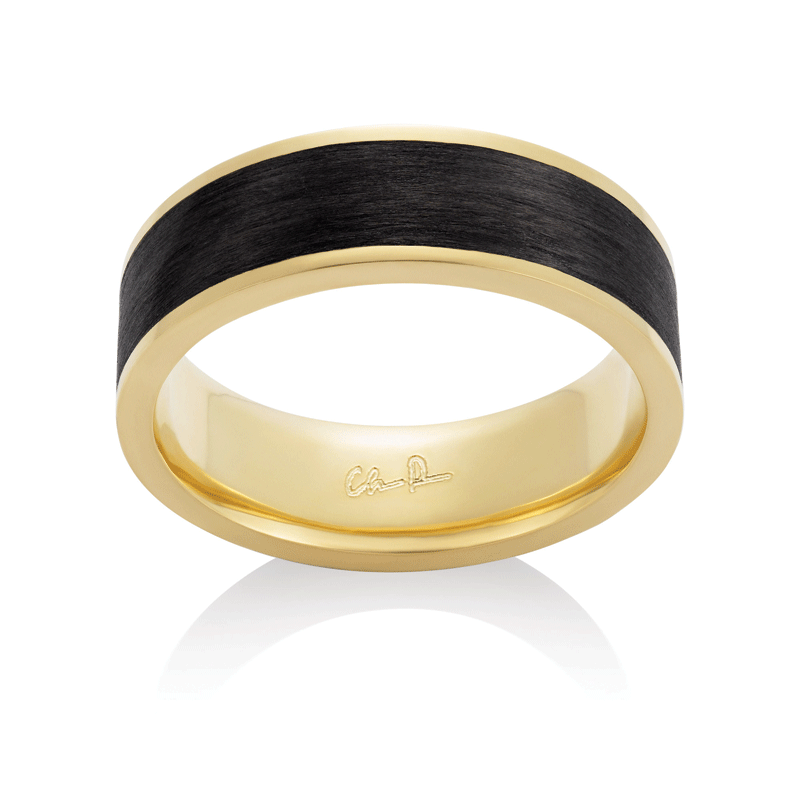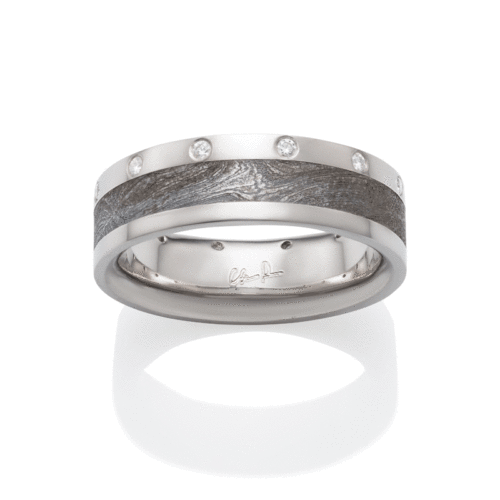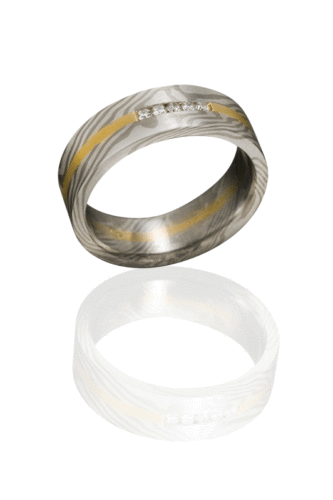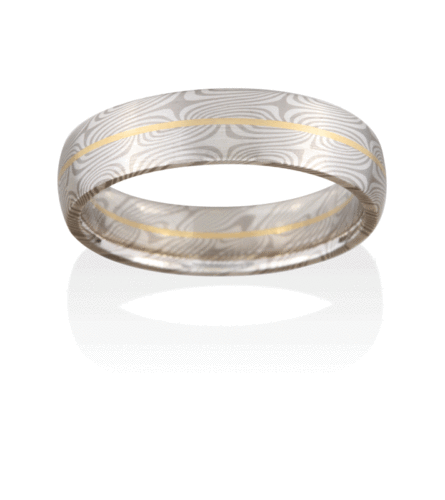By Chris Ploof

Many jewellery retailers and sales associates are well-versed in the bridal arena and know how to help brides and brides-to-be select engagement rings and wedding bands. Grooms, on the other hand, can prove to be a bit more challenging. For many men, the wedding ring is the first piece of daily-wear jewellery they buy. For others, jewellery—and rings in particular—may not be new territory at all. Yet, there are a few points of consideration that smart sales associates can share with grooms-to-be.

Sizing
When choosing a wedding band, it is especially important for grooms to consider how their choice of material impacts sizing. Savvy retailers will advise customers to choose carefully, making sure the ring will last a lifetime.
Many grooms are attracted to unusual or “cool” materials. But some of these are unsuitable for wedding bands, proving to work better for fashion jewellery. Rings made with wood, bone, or antler, for example, are not durable enough for a lifetime of wear and can make sizing difficult, or even impossible. It is important to lead your customers towards rings that can be sized. Nearly everyone’s weight fluctuates over their lifetime, so rings will need to be adjusted as
we age.
However, having a ring that can be sized, does not necessarily mean you will get back the exact same ring! Some manufacturers, particularly in the modern metals arena, simply swap old rings for new ones. Caution your customers to look for rings that can actually be sized, rather than traded. Here is an area where retailers can also do their due diligence.
At my shop, we get one or two inquiries per week from customers who have been told that certain materials cannot be sized. Well-meaning friends, family, and even jewellery retailers or other “experts” can be wrong! Especially around alternative materials like Damascus stainless steel, meteorite, or even carbon fibre. Other manufacturers, due to lack of understanding or expertise, have incorrectly told my customers my rings cannot be sized.
It pays to go directly to the source and get the truth from the actual maker of the ring before making an incorrect assumption.

Wear and care
Wedding rings will change and age with patina as a result of normal, everyday activities. The shiniest platinum finishes will become more matte over time, and matte finishes will burnish and become shinier. These changes are completely normal and are affected by the customer’s daily environment. The good news is that you, as a sales professional, can advise your customer about how they can keep their bands looking fresh for a long time. You can also offer to polish the ring every few years as a courtesy service to get the customer back in the store and continue the relationship.
While we are talking about wear, it is also important to consider environment. Hot tubs, swimming pools, and other corrosive environments can accelerate wear. Advise your customers to avoid exposing their rings to these environments.
Teach them how to clean their ring and/or offer a free cleaning service. Many manufacturers also have specific guidelines for ring care, based on the ring’s specific materials. Remember to encourage customers to follow the manufacturer’s care instructions.
If the ring has a polished surface, there are many polishing cloths that will help to gently restore the surface finish of the ring. Offer a polishing cloth as a free gift with purchase and use it in front of the customer as you finalize the sale to teach them.
For matte or other textured surfaces, make sure the customer understands that using a polishing cloth can actually harm the finish. For these types of rings, it is best to ask the manufacturer for specific tips to ensure they look great over a lifetime. If your store has a bench jeweller, offer to refinish the ring every so often.
These tips above work well for rings made out of metal. However, rings made with resin, wood, antler, bone—even when combined with metal—can prove especially difficult to maintain. To ensure your customer’s long-term satisfaction, encourage them to follow the manufacturer’s care guidelines for non-metal rings, even if they are mixed with metal.

Safety
Safety is another huge consideration. Rings can easily get caught and snagged on things, leading to skin tearing and serious injury. Anytime I am working on a ladder, or doing something that requires shifting heavy pieces of equipment, I am very aware that I can snag my ring. I always remove my wedding band at such times to keep myself safe. If your customers work a lot with their hands, it may be wise to recommend they remove their rings while working.
Many contemporary grooms are also attracted to metals that do not scratch readily (like cobalt chrome, and tungsten), but be aware these harder metals can also be very difficult or impossible to remove in an emergency, resulting in serious injury or loss of a finger. Consider steering your customer towards ring materials that can be cut and removed.
There is also a whole list of activities that can easily damage jewellery, and I would recommend not wearing a ring while doing them. For example, we see a few rings that were worn while lifting weights without wearing gloves—the surfaces were quickly destroyed by knurled weight bars. Some activities that can easily damage jewellery, especially rings, include weightlifting without gloves, rock climbing, gardening, stone wall building, and brick laying. My general rule of thumb is: If you are doing something involving a hard abrasive surface, take off your ring!

Loss
No one wants to lose their ring, but it does happen. There are a few scenarios to consider that will help your customer decrease the chance of losing their ring.
First, our fingers swell in the heat and contract in the cold, changing size quite naturally. On average, a change of around half a size may occur depending on season, diet, and exercise. Some individuals can fluctuate even more. I am an active outdoors man and am passionate about mountain biking, so I notice the changes in my finger size all the time. This type of fluctuation is normal, though, and smart sales associates should inquire about the customer’s climate (if they are not local) and their lifestyle before settling on a ring size. For outdoorsy and active individuals, it may be wise to recommend a slightly larger ring for easy removal in the warmer months.
In the winter, it is important to avoid pulling your ring off while removing gloves. This can be a disaster on the ski slopes or while mountain biking and hiking. Trying to find a ring in inches of snow or in the woods under fallen leaves is time consuming, if not impossible.
Another area where we see rings being lost is at the ocean or in lakes. If your customer spends time in the water, the cool water temperatures are likely to make their hands contract a bit. This could lead to rings being lost while swimming, surfing, or paddling. They should remove their wedding rings prior to any of these water activities.

Here’s hoping this information will allow you to help grooms-to-be as they make very important decisions about their wedding band. The more informed you are, the better you can help them find the perfect ring for a lifetime of wear.
Chris Ploof, an award-winning jewellery designer and metalsmith, founded Chris Ploof Designs in 2004. A specialist in modern metals, Ploof is a renowned expert in Damascus steel and Mokume Gane. His hand-forged metal jewellery designs are crafted in his solar-powered studio in Massachusetts. Ploof’s work has led to consulting projects all over the world, as well as multiple awards from the Santa Fe Symposium for his research and discoveries and countless mentions in various global trade publications.





